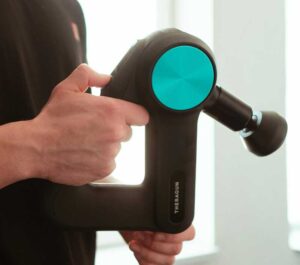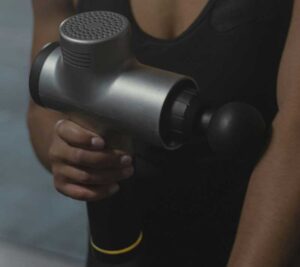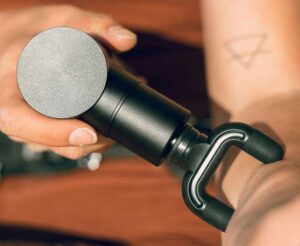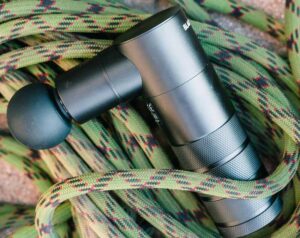As part of my preparation for a Spartan race, I have increased my walking. That has led to trouble with my IT band. The IT band, the Iliotibial band, is a tendon that runs from your hip to the top of your shin bone. The real name for what I have is Iliotibial Band Syndrome (ITBS). ITBS is caused when the IT band gets irritated or swollen – often from overuse. Which of course I have been doing because walking is my “go to” exercise.
 When I stretch correctly before my walks, the pain is more of a dull throb than a sharp stabbing. Heat and analgesics in addition to stretching also help. I was talking to a physical therapist in class a few weeks ago, and he suggested that I try a massage gun along with the other treatments. When doing all them together, my mobility has improved to a normal level.
When I stretch correctly before my walks, the pain is more of a dull throb than a sharp stabbing. Heat and analgesics in addition to stretching also help. I was talking to a physical therapist in class a few weeks ago, and he suggested that I try a massage gun along with the other treatments. When doing all them together, my mobility has improved to a normal level.
For those of you who don’t know what a massage gun is or what it does, you are in luck. From my “limited” knowledge I will try to help you understand.
Massage Guns
As you can see from the pictures, massage guns can take various shapes and come in different sizes. The general idea is that you are going to turn the gun on and select a level of intensity. Then gun is moved over the affected area to massage it with a minor pounding or percussive motion. Most guns have a way to adjust the intensity of the pounding/massage. Less expensive guns generally have a narrower span or degree of the pounding/massage. More expensive guns usually have more choices. To understand the difference, you might think of small, medium, or large shoes compared to 10 ½ EEE shoes. The more choices you have the more you can tailor the treatment to your exact needs. Some higher end guns may include the option of heat and/or cold as well as the pounding.
Attachments
 Not only are there different guns, but many also come with different attachments. Some are a little softer and are round while others will be hard and flat. You may also get attachments that look like fingers, a blade, or a pointer. Your massage gun should come with some instructions to help you choose the right attachment. Different areas of the body need different attachments and movements. It may also give you some guidance of the direction and pressure you should be using on that part of your body. If it doesn’t have that guidance or you want more information, do a YouTube search to get more information. The one note that should be included in the instructions is to not use the massage gun on bones or joints. At minimum it won’t have any effect on that area and may cause some damage to the bone or joint. The purpose of a massage is to work on the soft tissue in the body and the same principle applies to massage guns too.
Not only are there different guns, but many also come with different attachments. Some are a little softer and are round while others will be hard and flat. You may also get attachments that look like fingers, a blade, or a pointer. Your massage gun should come with some instructions to help you choose the right attachment. Different areas of the body need different attachments and movements. It may also give you some guidance of the direction and pressure you should be using on that part of your body. If it doesn’t have that guidance or you want more information, do a YouTube search to get more information. The one note that should be included in the instructions is to not use the massage gun on bones or joints. At minimum it won’t have any effect on that area and may cause some damage to the bone or joint. The purpose of a massage is to work on the soft tissue in the body and the same principle applies to massage guns too.
Power
 Most modern massage guns are battery powered with batteries. Those batteries get charged from a USB or other device-specific attachment. One consideration when looking at a massage gun is how often you will need to charge it. Read the reviews for a clues about how often you will need to plug it in. Another consideration is related to wanting to travel with your massage gun. How you pack for the trip may be an issue. Rechargeable batteries are usually lithium batteries. That means the gun can’t be packed in checked luggage. Since you will keep it in your carry-on luggage, the size of the gun is a consideration.
Most modern massage guns are battery powered with batteries. Those batteries get charged from a USB or other device-specific attachment. One consideration when looking at a massage gun is how often you will need to charge it. Read the reviews for a clues about how often you will need to plug it in. Another consideration is related to wanting to travel with your massage gun. How you pack for the trip may be an issue. Rechargeable batteries are usually lithium batteries. That means the gun can’t be packed in checked luggage. Since you will keep it in your carry-on luggage, the size of the gun is a consideration.
Final thoughts
My massage gun is helping me prepare for my race and will probably be part of my routine even after the race. They are relatively inexpensive and something you should consider if you have muscle and tissue related pain.
